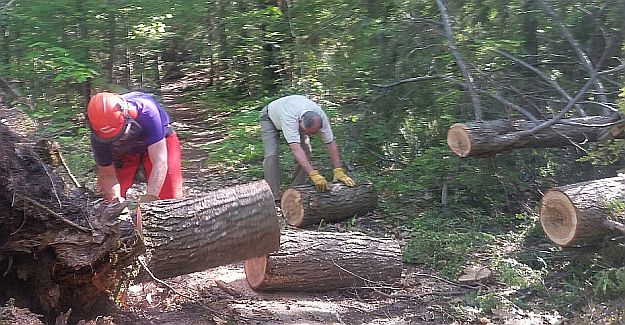
Peter Roderick (with helmet, chaps, and saw) and Andy Cook cut up a tree that had fallen across a trail on The Mountain in Rome. More…
Highlights from this issue…
- Another Ghostly Sighting
- How Invasive Plants Get Managed on a Farm
- Recyclable Plastics
- Saving the Family Cottage
- Training Future Lake Stewards
Download Full Print Edition [PDF] • Links to Other Pages on This Site
Trouble On the Lake: Another Ghostly Sighting
The guide ghosts of Great Pond [i.e. fishing guides who have gone to the Great Beyond] are certainly not a new phenomenon. Several years ago they were nearly caught partying out on Oak Island by Phil Cobb when he paddled his antique canoe there to check out mysterious music. Rod and Doris Johnson had a run-in with the ghosts a few seasons back, when returning from cousin Cary's camp around midnight. Last summer three separate incidents were called into the authorities by flatlanders, all relating to strange happenings on Great Pond.
Each time the guide ghosts were suspected as being the guilty culprits — at least by the locals. The cops seem to think we're all crazy up here and really don't follow up much. The guide ghosts' M.O. seems to include foggy weather conditions (assumedly when no one can get a good peek at their faces,) and most times they seem to like to party on one of the islands, occasionally in their boats.
One incident reported last year came from a fisherman caught out on Whale Rock, waiting for the fog to lift. He was nearly rammed by an old double-ended guide boat. His report included a vague description of the driver, said to be "a skeletal soul with wispy white hair." He also noted a rancid odor smelling of varnish, turpentine and home brew as the boat slid by, actually brushing his own Rangeley lapstrake.
The most recent return of the guide ghosts was just a couple of weeks back. It caused quite a ruckus with Doris and I, as we were actually caught in a strange weather phenomenon that included a period of unexpected fog.
We'd left the Mill Stream by boat after a nice meal at the Village Inn. There we had reconnected with old friends Steve and Edie Dubord and were invited for a "small snifter" (actually Uncle Byron's term for a night cap) at their summer home on Gleason's Shore. We hadn't caught up with them for years and were wicked excited to do so.
The dusky ride over with stars starting to appear was wonderful as the old '65 Lyman 19-footer, a gift from Bill and Joan Witkin, rode with her bow high and proud. The old GM 165 horsepower V6 was cuttin' 'em off just right at 3500 RPMs. We arrived ASAP and totally enjoyed the long chat time we had.
Time flew by and soon midnight was approaching and the little bird said it was time to go home. As we said our goodbyes and thanks to our hosts, we all walked out onto the dock. The sky did look a bit ominous, but not enough to be concerned, just another nice night on Great Pond. We could hightail it and be home in 15 minutes.
NOT SO, MY FRIENDS.
We left Steve and Edie and cranked up the revs of the so-called Iron Horse motor and headed out through a tricky area crossing the submerged esker that connects Pine Island and Horse Point. I'd done it a thousand times since childhood and knew the general route, as many of the marker buoys were not there when we were kids. We had learned and always used landmarks.
After leaving Oak Island on our port side and heading for the gut between the south end of Hoyt's and Long Point, I really had no worries about depth unless we slipped to starboard and got mixed up with the white ledges. A slight south wind had crept in and dampness was present. We cuddled for warmth while standing at the helm with the dual exhaust pipes bellowing in the night, smiling and realizing we had the world at our hands. How lucky could we be!
Then, out of nowhere, the engine started skipping and quickly things changed. Within less than a minute the old girl had quit running and we were adrift. Not the end of the world, but it got our attention. Darn, the bliss is over, what in the devil is wrong with this. One of us muttered something less polite.
While Doris held the quickly draining cell phone flashlight, I opened the motor hatch and did a quick overview. Coil wire in, no noted items unhooked. At this time, it became apparent that a fog was settling over us. With the engine problem and the weather quickly becoming socked in, things were going to hell in a handbasket. With little flashlight battery left, I asked Doris to hold it close to the distributor. We popped off the cap to inspect the points. Without a decent flat bladed screw driver, the Leatherman had to do.
At that time, we heard what sounded like an old violin or fiddle — and some muted voices from somewhere in the now heavy fog. Could this be a dream or did we drink some psychedelic wine? What in the devil is going on?
In fifteen minutes or so, the south wind had moved us a quarter mile or so, and a loud CLUNK sounded. We had drifted over the white ledges and our skeg had hit aground. Wow, the plot thickened. No motor, no steerage, thin water and very little flashlight left. Of all things, old men's raspy voices now semi-clear and very close, are added to the list above.
The next thing we knew the Lyman had drifted adjacent to a long double-ended guideboat, with no one aboard. An old hemp anchor line led over the bow and under the water holding the craft, and an old oil lantern was hanging on a hand-hammered shepherds hook stuck in the biggest rock out there.
I had been told as a child that the guides had drilled a hole in the big rock and set a lantern aglow each night to warn night boaters of the ledges. The old boys were at it again and we were about to finally witness one of their parties.
Before we could completely digest the events that had overcome us, a quick updraft of breeze came over the area. In a matter of minutes, the strange weather was leaving us as fast as it overtook us. Soon I saw the dull tiny green light on Glenn Baxter's point, and knew that the party was over. We may have scared them off and ruined the gathering. We were alone with no guide ghosts, and a quickly clearing sky with thousands of stars appearing.
By now we had drifted north of the ledges into some deeper water. With the last remaining flashlight power for light, we rolled over the crankshaft of the big V6 with a knucklebuster wrench on the damper pulley bolt head. Sure enough, the points had closed up as the set screw had loosened.
We opened the points and set them to a match book cover thickness, then tightened the set screw and put the cap back on. (This was an old trick that Fred Saxton, alias "Bucko," had passed along some 50 years ago while working on Pukin' Betsy, our fun old '26 Chevy.)
Doris hit the starter switch and, BINGO, the old girl fired up. None too soon as the flashlight went completely dead at that moment. We both chuckled, punched her up on a plane and headed to the Mill Stream. Just another day on the lake? We'd sooner think there's no doubt about it: The guide ghosts of Great Pond had once again, been caught red-handed!
▲ To Table of Contents • Print Article • To Other Links ▼
How Invasive Plants Get Managed on a Farm
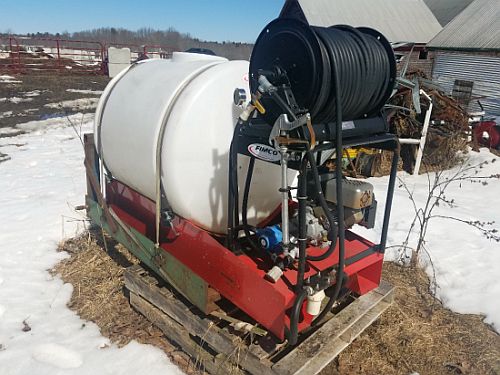
A 200-gallon tank used to spray herbicide.
A farm in Litchfield manages a dairy business with 88 head of cows. They are very focused and responsible farmers, and, like most dairy farmers, keeping their lands productive is on the top of their list of priorities. Just like so many landowners in Maine right now, they have had a problem that, if left unmanaged, can take over lands and prevent them from being productive or manageable: invasive species.
The invasive plants that have been pestering their farm for years are multiflora rose (Rosa multflora), Japanese honeysuckle (Locinera japonica) and Japanese barberry (Berberis thunbergii). Populations were growing on the field borders and even some spreading into the middle of the field. As they kept the fight going with different techniques, they decided to apply for USDA assistance and were granted dollars to control his invasive plant population through chemical control, under the practice of brush management.
In 2017, they decided to acquire a 200-gallon tank sprayer with 300 feet hose capacity which he mounts to his tractor to reach far into areas that may not otherwise be accessible. With this instrument and some technical assistance by NRCS planners, he tackled his invasive plants head on.
For chemical control he used two herbicides. The first one was a generic brand of glyphosate. The other was 2-4 D. He followed the label instructions. For the multiflora rose and Japanese honeysuckle, glyphosate was a very effective control method, but in the case of Japanese barberry, glyphosate was ineffective.
So he decided to buy 2-4 D and apply as the label mandated. He found that chemical to be very effective with barberry, as the effects could be seen rapidly. As he has dealt with invasives for years, he has learned to find which chemicals are more effective for certain plants.
As the population of invasive plants grows in Maine, landowners have become very aware that this is a state-wide concern. You can hear about different techniques producers are utilizing, from bush-hogging the fields, to pulling invasives with different types of homemade instruments.
This farmer schedules two full weeks to tackle invasives every year, and spends about $10-$15 an acre depending on the density of the plant population. Cost estimates from certified applicators were in the range of $50-$250 an acre. NRCS Brush Management helps pay for part of the practice, i.e. herbicide, some of the labor, and part of the cost of spraying equipment. The producer addressed 3 acres of invasive species under the program. They continue to control invasives on their own on an annual basis.
The real issue is taking the time to be able to do that. They acknowledged that it is unreal to think that you can eradicate the species in your property, but keeping them controlled and away from the pasture and cropland can be realistic goals. To quote the producer, "Stay with it, and try to keep up," he said about his method of control.
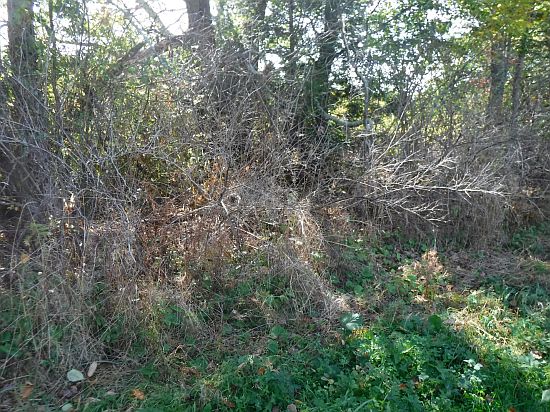
A Japanese honeysuckle after being sprayed with glyphosate.
It is very important to mention that there is a lot of guidance and technical assistance available. The Soil and Water Conservation Districts have been working side by side with the Maine Natural Areas Program to develop technical resources for landowners to identify, notify, and control invasive species on their land. In the last two years they developed invasive species surveys on agricultural lands that identify species, density of those species, methods of control and prioritization of attack.
The person leading the charge for the Maine Natural Areas Program is Nancy Olmsted, she is an Invasive Plant Biologist. Nancy has been very active in many communities around Maine to answer questions and provide great guidance on invasive species and how to deal with this issues in different types of landbases.
This week's guest columnist is a NRCS staff member working in the office of the Kennebec Soil and Water Conservation District in Augusta.
▲ To Table of Contents • Print Article • To Other Links ▼
Recyclable Plastics
Most of us have learned to identify recyclable waste plastics by a number 1 through 7 within a triangle stamped somewhere on the item. The number identifies the resin or mixture of resins that make up the plastic content. Over the years of recycling history, we, as the source of these particular solid wastes have come to trust that if it's plastic and has a number on it, it will be recycled.
Never have these numbers been so important as they are now, but for an unfortunate reason: A major buyer of American discarded but recyclable plastics, the country of China, has all but closed the door on further buying because they discovered they've been buying bales and bales of impure content: plastics mixed with batteries or paper, plastics covered with food, and plastics with dirty diapers mixed in. Thus, they've had to re-sort and discard at tremendous cost.
The jury is still out as to just where the blame falls along the recycling highway from your house to China, but there are many fingers pointing to the ease, convenience and profitability of single-stream sorting, pick-up and processing that has been adopted by many municipalities across the country. What this has meant is for U.S. towns and cities, large and small, is that the market for certain plastics, particularly 3 through 7, has dried up and, while still collected as recyclables in many communities, are in fact being landfilled. So far, plastics numbered 1 and 2 are still collected and sold for recycling.
Is There Something You Can Do?
Studies show that most Americans care about recycling and want to do it correctly. If you count yourself as one of these, find out your town's or city's current recycling policies and practices and follow them. Stay in touch and try to understand burdensome or unfortunate changes as the result of a continuum of events starting well beyond your town or city boundaries. If you're a seasonal resident remember that recycling policies and practices at your temporary address may be (and probably are) different from those of your home town.
Regardless of your jurisdiction's policies, there are some best practices for you when it comes to recycling plastics:
- Don't toss anything in a recycling bin or bag that contains leftover food or scraps. Rinse it out, then throw.
- Throw it in the right bin or bag. If you aren't sure, ask someone knowledgeable at town hall, city hall or the transfer station.
- Create less waste. It is estimated that Americans create 4.4 pounds of solid waste each day, much of it plastic and used only once.
- Recycle flexible (non-rigid) plastics by depositing them at grocery store or big-box store drop-off sites. This category includes retail bags, wraps, packaging, produce bags, paper towel and beverage overwrap, Ziploc bags, newspaper wraps and dry-cleaning bags. These plastics, while usually not stamped with a number, are recyclable but are not easily handled by transfer stations and recycling processors, and while they may be collected they are not welcome and usually landfilled. For more information on what products are made from these filmy plastics and for collection sites nearest you visit www.plasticfilmrecycling.com.
- Maine is one of only eleven states that has passed bottle bill legislation, a law that requires a minimum refundable deposit on beer, soft drink or other beverage containers which is refunded with their return when empty. The containers, many of which are plastic, are recycled by the source manufacturers. Please make sure you, your out-of-state friends and renters are aware of this Maine "tradition."
Future articles will focus on other aspects of solid waste management, including disposal (e.g. landfilling) and diversion (ways to avoid landfilling) of common individual and household wastes.
One can contact the author, Susan Littlefield, Belgrade resident, with comments or suggestions at selittlefield13@gmail.com.
▲ To Table of Contents • Print Article • To Other Links ▼
Saving the Family Cottage

The fifth edition of this 2009 book of legal advice is out and has been generously given to our Belgrade Public Library. When you have three lawyers writing 198 pages of common sense approaches to saving the vacation spot full of family memories, it is certainly worth a look. I do not pretend to understand the many complex issues of taxes, rentals, sharing a family cottage, but the Table of Contents will guide you: "Trouble in Paradise," "Minimizing the Federal Tax Bite," "Scheduling and Use," etc.
Our Maine term for a lakeside family home is camp, not cottage. The glossary in this book had Cabbage listed with two definitions: "(1) A vacation home larger than a cabin but smaller than a cottage; (2) something that must be spent each year for the privilege of keeping a cottage." Page 31 was helpful to my understanding: "According to the most recent U.S. census data, Florida leads in the number of seasonal recreational properties with 485,000, followed by California (239,000), New York (236,000), and Michigan (235,000). Three New England states claim the highest saturation of cottages: 16% of homes in Maine are cottages, followed by 15% in Vermont, and 10% in New Hampshire."
The husband/wife lawyer authors are accompanied by a third lawyer who is a fourth-generation Michigan cottage owner. Their expertise offers many plans to consider along with an up to date website to consult.
I was struck by the reference in this informative book to John Nash, Nobel Prize Winner for game theory. His story in A Beautiful Mind was a prize winning biography and movie. "Partition Planning" apparently seems to be the worst, according to Chapter 2. Other plans provide a smooth transition from one generation to the next. The "Rabbit Problem" can almost be figured out by anyone without checking the chart on page 30.
Mal Dawson gave me the book for our Belgrade Public Library after giving away many copies to friends who wondered how to save their Maine camps. The Great Pond lakeside home of Arthur Godfrey was purchased and moved to Dawson's property on a nearby lake years ago. It was first placed 75 feet back, but then moved again when Maine regulations changed to 100 feet back from the water line. It is now their guest house.
We also experienced that 75 feet change to 100 feet from the lake, so we sold our Jamaica Point land, with a Maine Conservancy contribution. Check out this library book which is Saving the Family Cottage: A Guide to Succession Planning for Your Cottage, Cabin, Camp or Vacation Home. Thank goodness Cabbage was NOT on the book jacket!
Elk Lake is in the dedication and the three authors all have Lake Superior and Michigan roots in vacation homes. Deborah Wyatt Fellows, Founder, Traverse, Northern Michigan's Magazine, waxes poetic in her foreword:
"As is true for so many families, the cottage was the elixir that brought our family closer together. And so it is some kind of tragic irony that, when the time comes to discuss changes in ownership…sorting out the particulars can shred the same family ties that the cottage made strong.
"Those families know that as the world moves faster and faster…there will always be a need for a simple place, bathed in sunlight and solace, that quite effortlessly brings us closer together."
▲ To Table of Contents • Print Article • To Other Links ▼
Training Future Lake Stewards
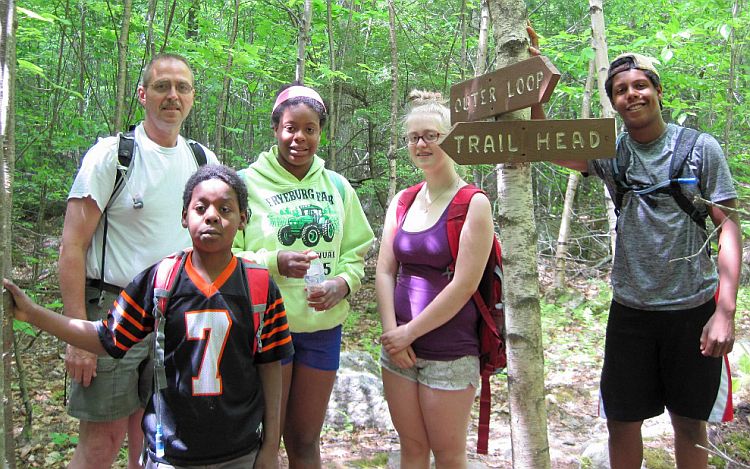
The Blauvelt Family from Farmington (L-R): Doug, Daniel, Temeeka, Alison, and Tyleek.
Although according to the calendar summer has barely begun, it is already flying by with lots going on. This has been another busy week with lots of activities with the various groups I work with.
For the most part, the weather has been dry and a bit windy, good for getting in a bit of hiking. I spent one afternoon clearing some blowdowns on the Great Pond Loop of The Mountain Trail with fellow 7-Lakes Alliance (formerly the BRCA) Stewardship Committee volunteers, Peter Roderick and Andy Cook. The 7-LA Stewardship volunteers spend a lot of time and effort keeping the local trails in good shape. If you would like to help, please sign up with Mary Kerwood at the MLRC to get on our volunteer list. The work is actually a lot of fun and you will meet some interesting, dedicated people.
The day before, I had been hiking the trail and met the Blauvelt Family from Farmington. Doug Blauvelt is the Cubmaster for the local Cub Scout Pack and the Assistant Scoutmaster for the Boy Scouts. He was scouting the Mountain Trail for possible hikes with the Cubs, Boy Scouts, and the 4H Club of Farmington. They had hiked Mount Phillip in the past and wanted to look at some of the other trails in the area to do hikes of different lengths with various groups. Helping him in that task were Daniel (Cub Scouts and 4H), Tameeka (4H), Allison (4H), and Tyleek (Boy Scouts). As a group, the family kind of epitomized the theme of this column: taking kids outside to gain outdoor experience and knowledge. I look forward to seeing them out on our trails in the future.
Among the many hats I wear, I serve as the president of the board of the Maine Lakes Society, a state-wide nonprofit dedicated to protecting the health of Maine's lakes for future generations through science-based education, action, and policy. In addition to overseeing the LakeSmart Program for lake associations across Maine, we have a program called LakesAlive, designed to help train tomorrow's lake stewards.
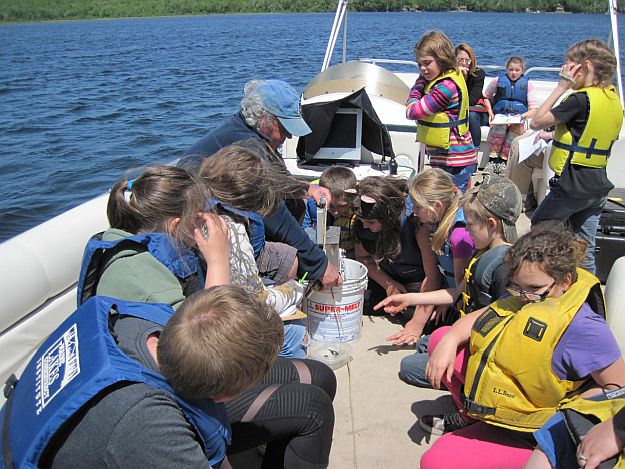
Academy Hill fourth graders on the Melinda Ann examine their "catch" from the benthic dredge on Wilson Lake.
This program includes a 30′ floating classroom, the Melinda Ann, that we use to take school students and other youth groups out on Maine lakes to give them some hands-on, experiential lake science, such as doing plankton tows and Secchi depth readings and learning to drive our video-equipped, remotely operated vehicle that allows them to inspect the depths of the lake. They also use a benthic dredge to capture critters and sediments from the bottom.
Last week, sponsored by the Town of Wilton and Friends of Wilson Lake, Phil Mulville and I towed the Melinda Ann to Wilson Lake where we took nearly 40 fourth-grade students from Academy Hill School (RSU 9) out on three trips, teaching them a bit about watersheds and lake science. The kids had a ball and learned a lot. On the plankton tow, they captured a real-life Cyclops zooplankton like the one on Sponge Bob Square Pants!
This area offers some great outdoor recreation, whether you like to hike, bike, birdwatch, fish, sail, or paddle a canoe or kayak. Pick up a map of the local trails at Day's Store or from the 7-LA at the Maine Lakes Resource Center. (Check out the Belgrade Lakes Association's LakeSmart Program while you are there). Get out and explore! Sign your kids up to learn to sail through the Great Pond Yacht Club. Keep an eye on the sign in front of the MLRC and check the 7-LA website and Facebook page for further updates. And make sure you take a kid along on your next outdoor adventure!
Print This Article • Print All Articles • Go Back To Top of Page

Download the Print Edition
The print edition includes all the above articles and much more. You can find a complete table of contents on p. 3. Adobe Reader is required.
◀— Previous Issue • All 2018 Issues • Archives • Business Directory • About Us • Home • Next Issue —▶
